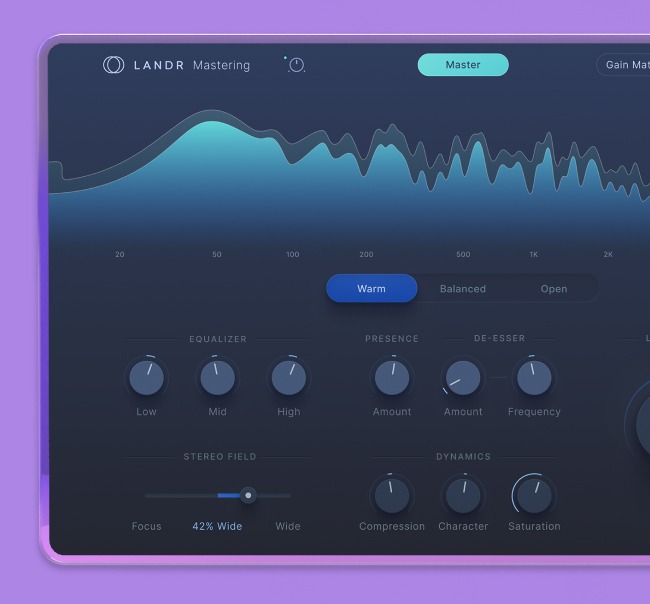
Vocal Chain: 8 Essential Mix Elements for Vocal Tracks

A good vocal chain is essential to the finished sound of a studio recording.
After all, vocal tracks need to sound polished and powerful to work for today’s audiences.
But what exactly goes into a pro vocal chain? What elements are included and how do they work?
In this article I’ll break down a typical vocal chain and explain how each part contributes when mixing music.
Let’s get started.
What is a vocal chain?
A vocal chain is a series of processors used by an engineer or producer to situate a vocal recording within a mix.
Typically made up of traditional mixing tools like EQ, compression and effects, vocal signal chains usually include specific production techniques used for vocals.
While many vocal chains may be similar, each engineer has their own choices of plugins or hardware that they use to create their signature sound.
Here are 8 common elements of a vocal mixing chain.
1. Low-pass filter
It’s common in vocal processing to add an EQ first in the chain to filter out any unneeded frequencies.
For vocals, these are typically low rumbling sounds or excess bass frequencies created by proximity effect.
🧠 Hot tip
In addition to removing problematic frequencies, a low-pass filter can improve the performance of other processors in the chain that react poorly to excessive low end.
Experiment with adding one at frequencies ranging from 40-85 Hz but try not to remove too much of low-end foundation of the singer’s voice.
Learn to mix vocals
Get the essential mix tips for powerful vocal tracks.

2. Compression
Compression is an essential ingredient in any vocal chain.
The human voice is a highly dynamic instrument. The sound energy of a singer’s performance can vary wildly between phrases, making it difficult to set the overall level so that each moment can be heard clearly.
The solution is to reduce the recording’s dynamic range using compression.
Dynamic range compression basics.
If you need the full guide to compression in audio, check out our overview.
But if you just need the basics, compression works by turning down the signal whenever it crosses a set threshold level.
Since the loudest parts of the signal get reduced, the rest can be turned up so that loud and quiet portions can both be heard.
When it comes to vocals, engineers often apply compression in stages.
One compressor may be set to tackle fast, peaky transients while a second might apply gradual levelling to even out the performance.
Check out our in-depth guide to vocal compression to learn more.
3. EQ
EQ is the next major step in a vocal chain. It’s the main tool for controlling the frequency balance of any sound, including vocals.
Studio vocals need to sound bold and powerful, but soar over the mix at the same time.
In most cases, you’ll need to make a few key EQ moves to achieve the right sound.
EQ explained in 4 minutes.
We covered the basics in our guide to vocal EQ, but every vocal recording is different.
In addition to finding the right frequencies, it’s important to choose the right EQ plugin for vocal mixing.
There are thousands of options, but in general you should opt for a smooth EQ that can make broad adjustments sound natural.
Here’s a quick list of the best EQ plugins for any situation in mixing.
4. Saturation
If you’ve applied compression and EQ, but you’re still struggling to get the right basic tone for your vocal track, you might consider saturation.
Saturation is subtle clipping and distortion that adds harmonics to your signal.
It can subtlety shift the tone of a sound and bring it forward in a mix by enhancing the upper midrange.
Be careful though, too much saturation can sound fatiguing and lo-fi if you’re not careful.
For this reason, many engineers use saturation in parallel on a bus or using a wet/dry mix control.
When blended in carefully, saturation can sometimes help vocals stand out in the mix.
5. De-esser
Sibilance is the harsh scraping sound that sometimes occurs when a vocalist sings the ‘s’ syllable in a phrase.
It can be especially distracting with some singers and microphones, so there’s a whole category of processor designed to help reduce it.
These are called de-essers. A de-esser is a specialized type of compressor that works by reducing the gain of the signal only when the harsh ‘s’ sounds take place.
Since some EQ and compression settings can make sibilance more apparent, most engineers use a de-esser at some point in their vocal chain to keep it under control.
6. Widening
So far, all the effects I’ve talked about would be applied one after the other in series.
They would be added to the insert effects portion of the channel strip for the main vocal track.
The next three would typically appear on aux send channels in a parallel configuration.
If you’re not sure how that works, check out our guide to audio routing, sends and returns to brush up.
If you just need the basics, all you need to know is any effects that create a separate wet and dry signal are most commonly used on separate tracks.
By setting the effects signal to 100% wet on its own dedicated aux return channel you can use the DAW’s mixer to precisely blend the wet and dry signals.
This makes it easier to manage in a busy mix.
One common effect used like this in a vocal chain is widening. Sometimes called detune or micropitch, widening is a subtle form of modulation effect that creates a sense of stereo depth.
It’s often used in vocal chains to create a larger-than-life, enveloping sound that makes a vocal sound three dimensional.
7. Delay
Another effect used on an aux send is delay.
Delay is the echo effect that creates rhythmic repeats that decay away into ambient wash.
It can be subtle or psychedelic, but it’s a key component in vocal chains for the way it helps a vocal blend into the texture.
One common type of vocal delay is a short stereo setting with slightly different delay time parameters for the left and right repeats.
This can create a sense of width and space somewhere in between reverb and widening.
There are many different styles of delay to choose from, so head over to our guide to the best delay plugins if you want to explore this effect type.
8. Reverb
Speaking of which, reverb is the final essential ingredient in a vocal chain.
Reverb simulates the reflections from the surfaces in an acoustic environment that situate a sound in space.
Since studio vocals are recorded in the isolated environment of a vocal booth, some ambience must be added after recording to make it sounds natural.
Vocal reverbs can simulate many types of environment, from a tiled bathroom to a massive cathedral.
Vocal processing
While the effects I mentioned above are common in vocal chains, they’re certainly not the limit of what you can add to your vocal tracks.
After all, your approach to mixing is completely up to you—there’s no rules!
That said, if you’re looking for a place to start, these suggestions will give you some solid ideas to begin with.
If you’ve made it through this article you’ll have a great start for crafting your own vocal chains.
Gear guides, tips, tutorials, inspiration and more—delivered weekly.
Keep up with the LANDR Blog.


















